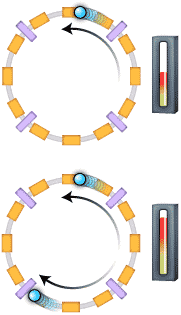|
 |
|
Maximum collision energy is obtained when
two particle beams collide head-on.
|
|
|
|
To achieve very high collision
energies, many of today's accelerators are colliders
in which two particle beams are accelerated in
opposite directions and are made to collide head on
inside the accelerators. In these collisions
practically all the particle energy can be used for
particle production. This is the most efficient and
economic way to obtain high collision energies to
explore the interior of matter and to produce new
particles. Huge detector systems surround the
collision point and register what is happening in the
collision.
In 2005 the new collider at
CERN (the LHC, the Large Hadron Collider) is expected
to accelerate protons to the highest energies ever.
Two beams of 7 TeV protons will collide head-on and
physicists will be looking for new processes like the
Higgs mechanism.
|